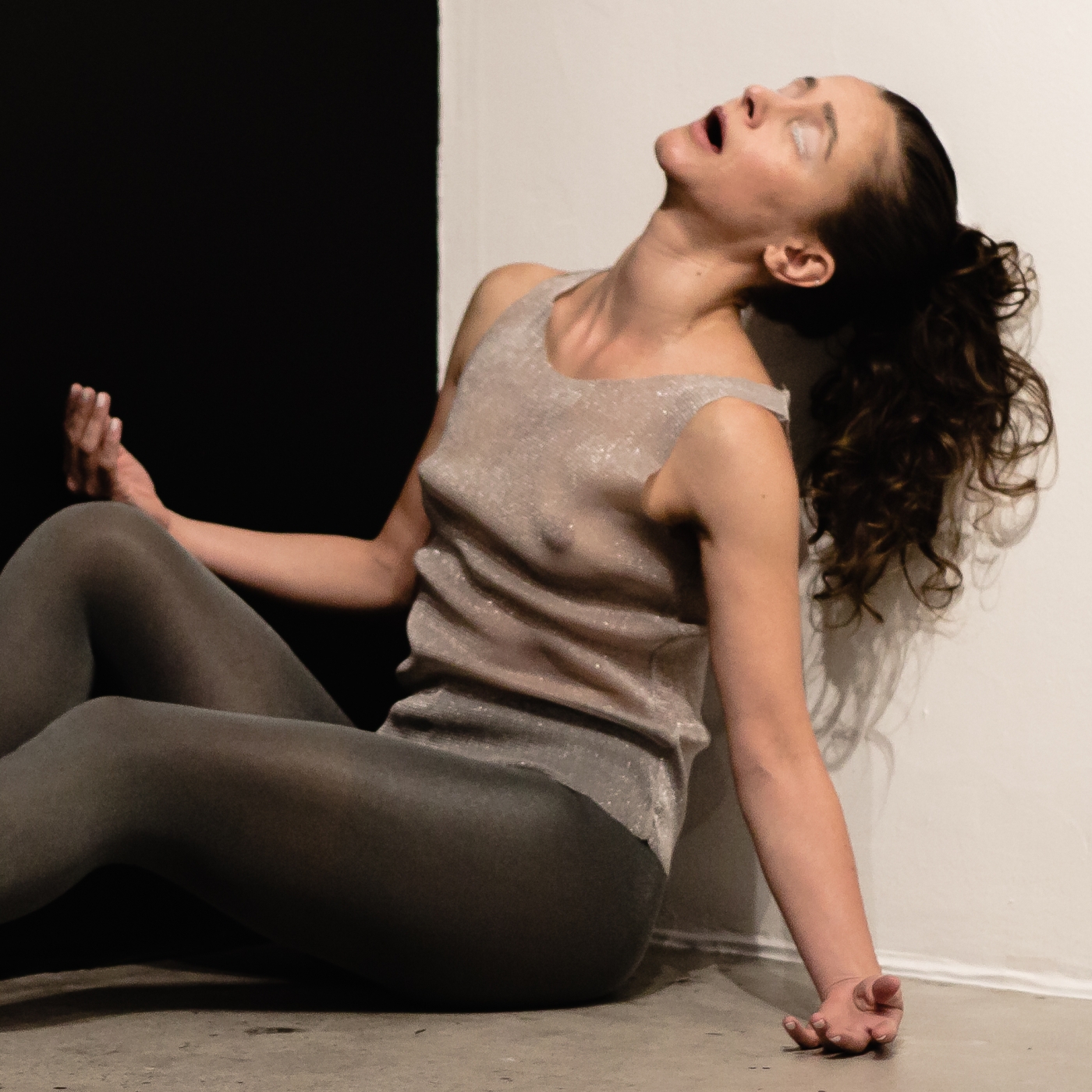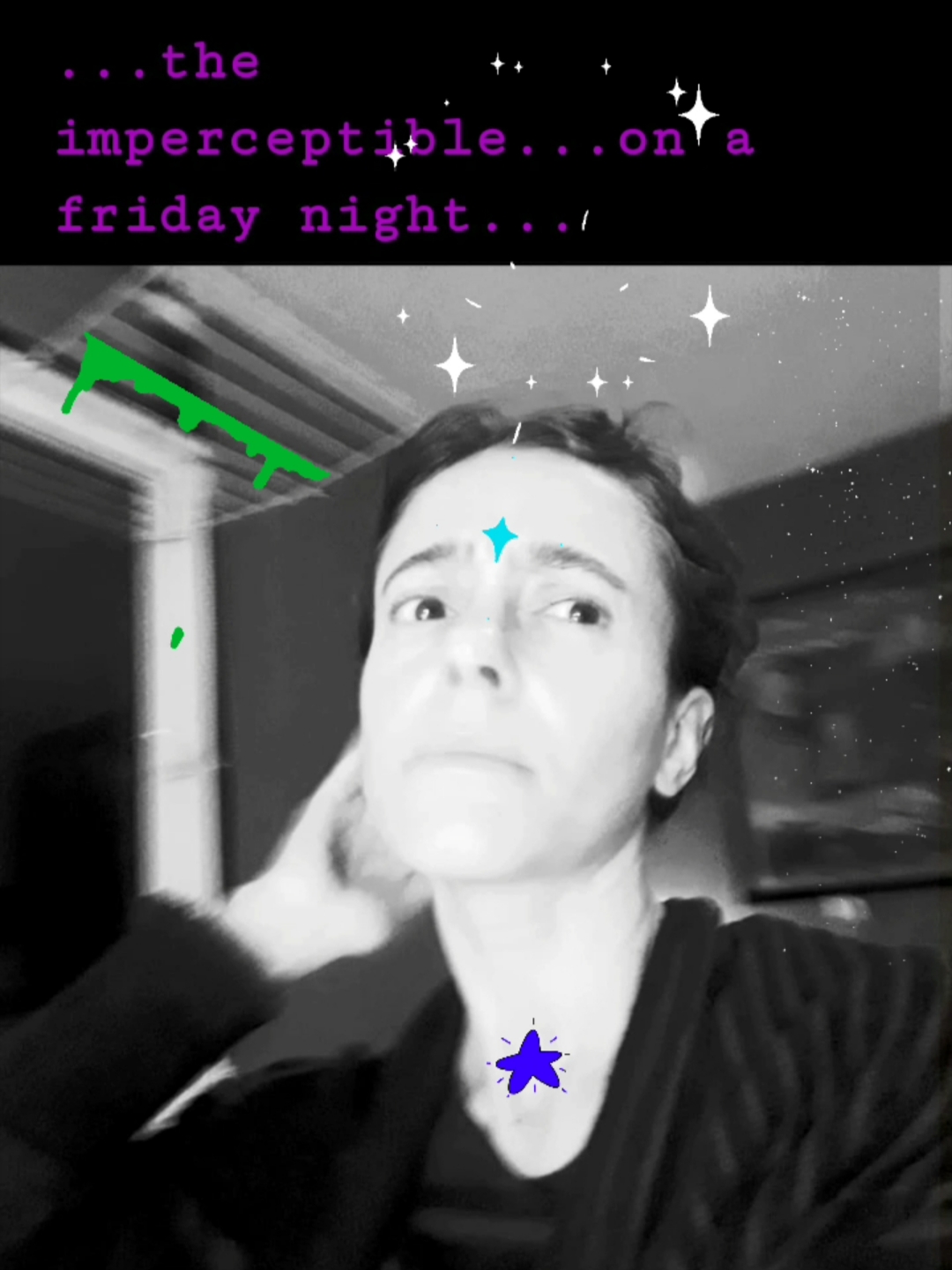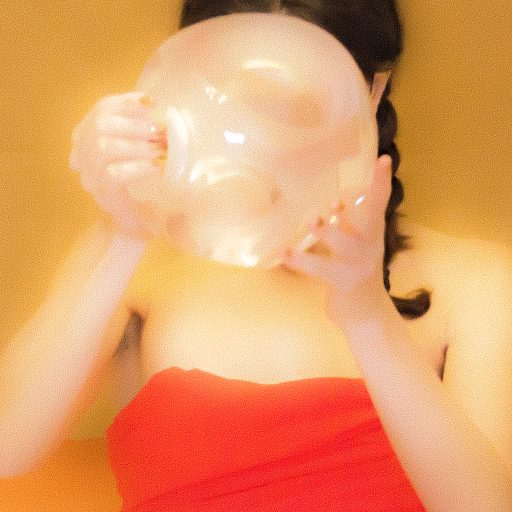Fiction, the algorithm, the Jaguar, the Body, the imperceptible, and Derrida
> reflective journalNovember, 2019
Fiction and the Algorithm
During the process of writing the essay Mythopoetics and hospitality in participatory performances, I was intuitively drawn into creating instagram stories that would somehow synthesize moments when I had unexpected insights. The action of framing these events within an image-based platform was a way to synthesize them outside the constraints of written language. It was also a way to connect to the ‘outside’ while engaging in lonely labor. By publishing these materials in a public online platform, I place them in different realms of time and I materialize desires of how to be seen; it is an exercise of ‘self-creation’ in a virtual space.
When published as insta stories, images and videos become uncontrollable fiction and reach other instagramers’ algorithmically ordered feeds. It is impossible to know the dramaturgies into which they were – and can continuously be – inserted. I realized that the published materials had the ability to reconnect me to the moments they synthesize better than the contents of my notebook alone. Posting a story while studying, researching, writing, was a way to manifest the desire to talk about specific topics I was immersed in during those lonely moments. I was interested in connecting the essay writing practice – new to me – to the practice of using social media as a way to make humor more present in the process. For these reasons this reflective journal is constructed around my instagram stories and other selected images both from previous works and from the intensive period in Arnhem. Enjoy …
JAGUAR . ONÇA PINTADA . JAGUAR . ONÇA PINTADA . JAGUAR . ONÇA PINTADA


When watching a video of the lecture-performance BE AS IT MAY,
by artist Perrine Bailleux,
I saw a jaguar in the iconic painting Black Square (1915) by
Russian avant-garde artist Kazimir Malevich

CAN YOU SEE IT?
Due to my current obsession with Amazonian Studies through the works of Eduardo Viveiros de Castro, Davi Kopenawa and Bruce Albert, Aparecida Vilaca and Ailton Krenak, I’ve been challenged and transformed by the idea that a shaman can become a jaguar. And many other things.
This fascination with ‘otherness’ appears in the lists of words about ‘the body in my artistic practice’, written during the BiP workshops; mainly under ‘what the body in my practice is willing to risk…’: its current identity, its rationality, its expectations, its ready-made answers, its ontological category, its fear, its appropriateness. In a way, the list written without much analytical consideration, following a more intuitive mode, revealed my desire for constructing a body that can ‘become something else’. What strategies could I use in order to pursue such desire? What kind of fiction would I need to construct to deviate from what my body already knows?
In the second lecture of the module Body in Performance, when speaking about the rules of society that constitute normativity, the word ‘fiction’ came up. If fiction implies the suspension of the rules of society, performance always creates fictional spaces. Of course some performances work with more layers of fiction than others, but the acknowledgement of the performance event by the spectator and, consequently the suspension of the rules of society, creates the first fictional layer. Since then, I’ve been considering the question: how I am using fiction in my work?
By looking at my work from a Derridean perspective – identifying iterability and differànce – I observed the layers of fiction. I then realized I’ve been addicted to creating fictions for the past few years. Choreographic scores, impersonations, internal landscapes. But what’s next? What fictions do I need to create in order to develop my current research? Is it a fiction of the body? Will I deal mainly with internal landscapes? Is it a fiction of the choreographic score? What other approaches will I uncover? What experiences do I want to foster by creating fictions?

Sinuosity: the muse at MIS - Museu da Imagem e do Som em São Paulo | photo: Ivan Oliveira
When choosing the theme of my essay, I decided to write about The Oracle Dance; a choreographic score that produces performances that create what I finally named as “tension between empirical-theoretical thought and mythopoetic thought”. In the performances, the participants engage in a belief system other than the normative in Western societies. During an invented ritual based on a premodern system of divination, The Oracle Dance exposes the ‘imperceptible’ – powers of connectivity between all things, forces that do not have a discernible form.
Analyzing such work directly informed my research, for my interest lies in Amazonian populations’ ideas around the body. Such concepts belong in a world in which two bodies can occupy the same space at the same time and humanity is a position to be continually redefined. Since I cannot escape dealing with ‘impossibilities’ and with the ‘imperceptible’, it seems I will have to develop a fiction that can persuade other beings to follow my body into the abyss. A fiction that can persuade other beings to follow a body that passes through itself, that follows the movements of thoughts and demands connection and commitment.


Derrida and the Paradox of Hospitality
While writing about The Oracle Dance I encountered Gere & Corris’ ‘aesthetics of hospitality’. This notion is based on Derrida’s concept of hospitality: the paradox of a conditional hospitality driven by an impossible absolute hospitality. On the one hand, hospitality is always conditional and based on context. On the other hand, it always has the absolute, the unconditional opening to the other as a horizon, as the condition for its existence. Hospitality always involves mastery and control over our space. Without it, one would not be able to ‘host’ a ‘guest’.
If the value of a performance can be placed upon the world it proposes; in the worlds proposed through ‘aesthetics of hospitality’, there is connectivity and openess to alterity; an openness to the “Other”. I find that important in the moment we live in, when it has become difficult to imagine what a desired future could look like. As Bojana Cvejić and Ana Vujanović wrote in The Crisis of Social Imagination, neoliberalism makes it not possible for people to envision a future. In the arts, there’s an urgency for inventing new modes of existing, a need for ecology and sustainability. In Brazil, for example, the Ministry of Culture has been extinguished and a right-wing religious fanatic was nominated as the Secretary of Culture, which is now part of the Ministry of Tourism. So I am very interested in the value of imagination, which goes beyond criticism in an art work. In ‘aesthetics of hospitality’ we may be able to, at least, foster the imagination of how to remain open and hospitable to the other.


Derrida’s decision to feed his cat and his guilt at not feeding all the other cats
is an example of the paradox of hospitality
“There is no world, there are only islands”
“…between my world and every other world, there is initially the space and the time of infinite difference, of an interruption incommensurable with all the attempts at passage, of bridge, of isthmus, of communication, of translation…”
“…between my world and every other world, there is initially the space and the time of infinite difference, of an interruption incommensurable with all the attempts at passage, of bridge, of isthmus, of communication, of translation…”
These statements by Derrida have triggered my desire connect to the ‘imperceptible’, powers of connectivity between all things. What actions can keep us in a permanent state of ‘becoming’, in permanent connection with the ‘Other’? Is it possible to actually present rather than represent that? Is translation an inevitable process? Maybe translating data from one medium to another could be considered a bridge between ‘islands’: translating space into sound (as Iannis Xenakis has done), translating one’s DNA into a piece of clothing (as a Brazilian digital fashion brand has done). Maybe translating data from a forest into sound could mean displacing it; bringing a forest into a desert by replaying its sound. Maybe reconstructing a body through the embodiment of data belonging to other bodies. Considering the human body a technological masterpiece that is in constant process of transformation and exchange with the environment, it seems like it can become anything it wants to be.
The lists about ‘the body in my artistic practice’, written during the BiP labs, suggest a body that is always in between, a paradox; a vulnerable body that holds the power of transformation. A body connected to the imperceptible, to the formless. A body that demands air, trust, imagination, connection, madness and superpowers. It is an island that desires to create a world where imperceptible powers matter. But how to make this world tangible, how to think of the future and still materialize ‘something’, bringing the future into the present?


Back to the Present
When reflecting on the importance of imagination and openness to ‘otherness’ in performance practices as means to move beyond criticism, I find Irit Rogoff’s writing in From Criticism to Critique to Criticality to be very relevant. Rogoff stresses the link between artists and theorists; the impossibility of separating their existences and practices under the influence of poststructuralists, such as Deleuze and Agamben. Postructuralist ideas collapsed modern dichotomies, such as ‘inside’ and outside’, replacing them by more complex categories that allow for the examination of naturalised assumptions, values and thought structures. According to Rogoff, postructuralist tools prompted a move from criticism – that applies values and judgement to point out faults – to critique, that re-examines the logics and operations of the truth claimed by the modernist paradigm. Finally, in criticality we would have a double occupation: to be “both fully armed with the knowledges of critique, able to analyse and unveil while at the same time sharing and living out the very conditions which we are able to see through”.
Transposing Rigoff’s thoughts on criticality to my performance-making, the challenge could be to search for new lenses to observe what I already know (which is the only possible starting point) and consequently provoke myself to rethink structure. The new lenses could open up possibilities, allowing for the creation of deviations in my artistic practice.

“Criticality is taking shape through an emphasis on the present, of living out a situation, of understanding culture as a series of effects rather than of causes, of the possibilities of actualising some of its potential rather than revealing its faults”.
Rogoff’s words bring me back to the idea of imagination and to Derrida’s paradoxical hospitality as tools for materializing aspects of a possible future into the present. If criticality is connected “with risk, with a cultural inhabitation that performatively acknowledges what it is risking without yet fully being able to articulate it”, investing in the knowledge of the body and its potential for transformation could point towards a type of cognition other than problem-solving. However, this type of cognition could not be articulated by the parts of my body that construct and process verbal language, what brings this refective journal to a suspension…
This journal is a reflection on some of the contents covered in the module Body in Performance, part of the Master Performance Practices programme at ArtEZ University of the Arts. Led by Dr. Pavlos Kontouriotis, the module was delivered in September 2019, our first intensive period in Arnhem, Netherlands. The journal aims to provide a “critical reflection on my collection of notes, images, short texts, observations, thoughts and other relevant materials related to and reflective of the practices and challenges of embodiment module”. It is a personal journal and reflects on the content above mentioned in relation to my artistic practice and experience.
References Deleuze, G. and Guattari, F. (1987). A Thousand Plateaus: capitalism and schizophrenia. Minneapolis: University of Minnesota Press.
Derrida, J. (1971). Signature, Event, Context . Derrida, J. (1982). Margins of philosophy. Chicago: University of Chicago Press. pp. 307-330.
Di Paolo, E. and Thompson, E. (2007). The Enactive Approach. Available at: https://evanthompsondotme.files.wordpress.com/2012/11/9780415623612c07.pdf (Accessed: 14 November 2019)
Gere, C. and Corris, M. (2008). Non-relational Aesthetics. London: Artwords Press.
Love, J.O. (1970). Worlds in Consciousness: Mythopoetic Thought in the Novels of Virginia Woolf. Berkley: University of California Press.
Nobody’s Dance (2015) as part of Nobody’s Business Platform, Stockholm. Facilitators: Eleanor Bauer and Ellen Söderhult. Available at: https://nobodysbusiness.wordpress.com/portfolio/nobodys-dance-brussels/ (Accessed: 27 October 2019).
Perez, Victoria. (2015). About Research in the Arts: A lover’s Discourse. Available at: http://Perez, Victoria. About Research in the Arts: A lover’s Discourse. http://www.scielo.br/pdf/rbep/v5n3/2237-2660-rbep-5-03-00533.pdf (Accessed: 16 November 2019)
Rogoff, I. (2003). From Criticism to Critique to Criticality. Available at: http://eipcp.net/transversal/0806/rogoff1/en.html (Accessed: 14 November 2019).
“The Oracle Dance via Eleanor Bauer” at Danspace Project (2016), New York. Available at: http://www.danspaceproject.org/calendar/eleanor-bauer-the-oracle-dance/ (Accessed: 27 October 2019)